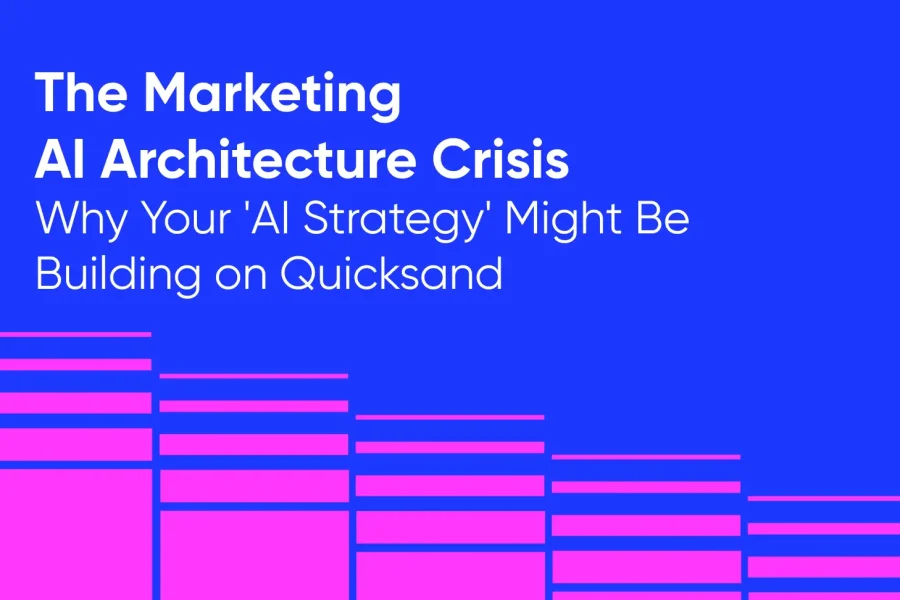Picture this:
Your marketing team just invested six months and a significant budget implementing an “AI-powered” solution. The vendor demo was impressive. The ROI projections looked stellar. Your team was genuinely excited.
Three months later, you’re staring at underwhelming results, frustrated team members and a sneaking suspicion that you’ve been sold a sophisticated hammer when what you really needed was a precision scalpel.
If this scenario feels uncomfortably familiar, you’re not alone. And more importantly, you’re not the problem.
The Hidden Crisis: Everyone’s Building on the Wrong Foundation
Here’s what most marketing leaders don’t realize:
67% of marketers aren’t adopting AI because they feel they don’t have enough knowledge and training to use the technology, according to the Marketing AI Institute’s 2024 State of Marketing AI Report. Even more telling, only 35% feel very confident in evaluating AI solutions.
But here’s the twist: this isn’t actually about lacking AI knowledge. It’s about lacking architecture knowledge.
Think of it like hiring a contractor to build your dream house, but nobody ever discussed whether you need a cozy cottage, a sprawling ranch, or a multi-story urban townhome. You might get an expertly built structure, but if the foundation doesn’t match your lifestyle, you’ll be miserable regardless of the craftsmanship.
The same principle applies to marketing AI. The technology might be flawless, but if the underlying architecture doesn’t match your specific marketing challenges, you’re building on quicksand.
The Expensive Mistake Hidden in Plain Sight
Consider these eye-opening statistics: 97% of marketing automation implementations are considered successful (only 3% report failure), according to Statista. Meanwhile, only 1% of company executives describe their gen AI rollouts as “mature”, per McKinsey’s latest research.
What’s happening here? How can automation be wildly successful while AI implementations struggle to mature?
The answer lies in understanding that successful automation isn’t about the AI itself—it’s about choosing the right architectural approach for your specific marketing reality.
Your competitors aren’t just using AI. They’re using the right AI architecture for each distinct marketing challenge. And that architectural choice is what separates transformation from frustration.
Why Architecture Choices Make or Break Your Marketing AI
Let’s get practical for a moment.
Your marketing team faces fundamentally different challenges throughout the week:
- Monday morning: You need quick creative variations for an urgent campaign launch.
- Wednesday afternoon: You’re optimizing budget allocation across five channels while campaigns are actively running.
- Friday strategic session: You’re planning next quarter’s complex product launch that involves 12 touchpoints and 3 market segments.
Here’s the problem: Most marketing teams try to solve all these challenges with the same AI approach.
It’s like using a Formula 1 race car for grocery shopping, school pickup, and weekend camping trips. Each vehicle might be excellent, but none are optimal for every situation.
The companies seeing exceptional results like the 63% of companies that outperform their competitors using marketing automation understand something crucial: different marketing scenarios require fundamentally different AI architectures.
The 5 Architectures That Actually Transform Marketing Operations
Over the next six weeks, we’ll explore the five proven architectural approaches that turn marketing AI from an expensive experiment into a competitive weapon:
-
Prompt Chaining:
The assembly line approach that turns complex campaigns into predictable, error-free workflows. Perfect for systematic campaign development where each step builds on the previous one.
-
Parallel Processing:
The simultaneous execution model that handles time-sensitive, multi-channel launches. Think of it as your marketing team’s version of parallel computing.
-
Orchestrator-Workers:
The conductor-and-orchestra architecture where a central AI breaks down strategic objectives and coordinates specialized worker agents. Ideal for complex initiatives requiring diverse expertise.
-
Autonomous Agents:
The self-improving systems that continuously optimize performance based on real-time data and predefined business rules. Your 24/7 marketing consultant that never sleeps.
-
Workflow Architecture:
The GPS for marketing operations—structured yet adaptive processes that ensure consistent execution while accommodating variables and exceptions.
Each architecture excels in specific scenarios. Choose correctly, and you’ll see results like the 80% of marketing automation users who experienced increased leads and the 77% who achieved higher conversion rates. Choose poorly, and you’ll join the ranks of frustrated teams wondering why their AI investment isn’t paying off.
The Competitive Advantage You Can’t Afford to Miss
Here’s what’s at stake: while 76% of companies are already using marketing automation according to multiple industry studies, 71% of marketers are using AI automation in less than a quarter of their tasks. This gap represents a massive opportunity.
Your competitors are likely making the same architectural mistakes you might be making. The companies that figure out the architecture piece first will pull ahead dramatically. Not because they have better AI, but because they’re using appropriate AI.
Consider this: 92% of companies predict that marketing automation will be crucial to staying competitive in their industries by 2024. But “marketing automation” without the right architectural foundation is just expensive noise.
What You’ll Discover in This Series
Each installment of this series will demystify one architecture through real marketing scenarios you face every day. No technical jargon. No theoretical concepts. Just practical guidance on when and how to implement each approach.
You’ll discover:
- Specific use cases where each architecture excels (and where it falls short)
- Real-world examples of teams transforming their operations with the right architectural choice
- Implementation frameworks you can use immediately, regardless of your current tech stack
- ROI calculations that help you make the business case to leadership
- Decision trees that guide you to the optimal architecture for your unique situation
By the end, you’ll have something most marketing leaders lack: architectural literacy that turns AI from a mysterious black box into a strategic asset you fully understand and control.
The Path Forward: Stop Building on Quicksand
The question isn’t whether AI will transform marketing it already is 69.1% of marketers used AI in their marketing operations in 2024, according to Influencer Marketing Hub.
The question is whether you’ll be among the leaders who get their architectural foundation right, or among the majority still struggling with mismatched solutions.
Here’s Your Action Plan:
Follow this series to explore how the right AI architecture can reshape your marketing operations. Each new installment will dive into one specific architectural approach complete with examples, use cases and actionable guidance.
Because while your competitors are still debating whether to adopt AI, the real opportunity lies in adopting the right AI architecture for your unique marketing challenges.
Remember, your competitive advantage doesn’t come from just having AI.
It comes from having the right AI, working the right way.
Stay tuned for next blog of our series 👉 The Marketing Assembly Line Revolution: Why Prompt Chaining Is Your Campaign’s New Best Friend
Ready to stop building on quicksand?
Let’s build smarter starting with the architecture.
Want to discuss how these architectures apply to your specific marketing challenges?
Explore our Agentic AI services or calculate your potential ROI with our Agentic AI ROI & Efficiency Gains Calculator


